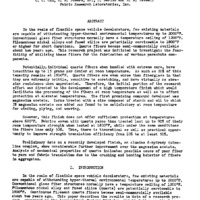Development of Quartz Fiber Parachute Materials
Item
- Title
- Development of Quartz Fiber Parachute Materials
- Date
- 1963
- Date Issued
- 1963-01
- Publisher
- Wright-Patterson Air Force Base, OH : Directorate of Materials & Processes, Aeronautical Systems Division, Air Force Systems Command
- DoD Project
- 7320 - Fibrous Materials for Decelerators and Structures
- DoD Task
- None Given
- Abstract
-
In the realm of flexible space vehicle decelerators, few existing materials are capable of withstanding hyper-thermal environmental temperatures up to 2000°F. Conventional glass fiber structures normally have a temperature ceiling of 1200°F. Filamentous nickel alloys and fused silica are potentially serviceable to 1800°F or higher for short durations. Quartz fibers became semi-commercially available about two years ago. This research project was initiated to investigate the feasibility of utilizing these fibers for the fabrication of various parachute components.
Potentially, individual quartz fibers when handled with extreme care, have tenacities up to 15 grams per denier at room temperature. As much as 50% of this tenacity remains at 1800°F. Quartz fibers are even worse than fiberglass in that they are extremely brittle, sensitive to scratching, and have virtually no abrasion resistance when unprotected. Therefore, the initial portion of the research effort was directed to the development of a high temperature finish which would facilitate the processing of the fibers at room temperature as well as to afford protection at elevated temperatures. The first promising compound developed was magnesium acetate. Yarns treated with a size composed of starch and oil to which 3% magnesium acetate was added was found to be satisfactory at room temperature for winding, plying, and weaving.
However, this finish does not offer sufficient protection at temperatures above 600°F. Fabrics woven with quartz yarns thus treated lost up to 90% of their room temperature strength when tested at 1800°F, while under the same conditions the fibers lose only 50%. Thus, there is theoretical as well as practical opportunity to improve strength translation efficiency from 10% to at least 50%.
Preliminary data on a recently developed finish, an alumina 8-hydroxy quinoline complex, show considerable further improvement over the magnesium acetate. Analysis of mechanical properties of quartz indicates possible cause of poor fiber to yarn and fabric translation due to the crushing and bending behavior of fibers in aggregates. - Index Abstract
- Contrails only
- Laboratory
- Directorate of Materials & Processes
- Distribution Conflict
- No
- Distribution Classification
- 1
- Identifier
- AD0299030
- DTIC Record Exists
- No
- Report Availability
- Full text available
- Creator
- Chu, C. C.
- Barish, L.
- Kaswell, E. R.
- Powers, D. H., Jr.
- Extent
- 18
- Corporate Author
- Fabric Research Laboratories, Inc.
- Report Number
- ASD TDR 62-964, p. 217-233
- Provenance
- Lockheed Martin Missiles & Fire Control
- Type
- article
- Relation
- This paper was presented at the Directorate of Materials and Processes "Symposium on Fibrous Materials" held in Dayton, Ohio, on 16-17 October 1962
- Format
- 1 online resource (18 pages)
- Is Part Of
- Symposium on Fibrous Materials
- Media
 ASDTRD62-964paper11.pdf
ASDTRD62-964paper11.pdf
Linked resources
Warning: Undefined array key "id_concat" in /var/www/html/omeka-s/themes/foundation/view/common/linked-resources.phtml on line 40
Warning: Undefined array key "property_alternate_label" in /var/www/html/omeka-s/themes/foundation/view/common/linked-resources.phtml on line 41
Warning: Undefined array key "property_label" in /var/www/html/omeka-s/themes/foundation/view/common/linked-resources.phtml on line 43
| Title | Class |
|---|---|
| Symposium on Fibrous Materials |